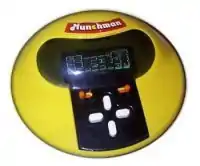Munchman (tabletop electronic game)
Munchman is a tabletop electronic game that was released under licence in 1981[1] in the UK by Grandstand.[2] It is a rebadged version of the Tomy game known as Pac Man in the United States and Puck Man in Japan.[3]
| Munchman | |
|---|---|
 | |
| Publisher(s) | Grandstand |
| Release |
|
| Genre(s) | Maze |
Overview
The game is based on Namco's Pac-Man arcade game with obvious limitations due to the simplicity of electronic game technology of the time and the dependency on a VFD screen. The game has a distinctive visual style due to its circular shiny yellow casing. The game should not be confused with a much smaller Grandstand handheld game of the same year called Mini-Munchman.
Hardware
The Munchman game runs on six volts DC and can be powered by four 'C' type batteries or alternatively via a low voltage mains adaptor.[4] As the display is based on VFD technology, it allows bright, multicoloured in-game elements to be rendered but at the cost of a relatively small screen size. The VFD display is manufactured with the pre-formed, immutable in-game objects effectively fixed in place onto a dark background. Each element can be individually lit or unlit during play, giving the illusion of animation and movement. In-game objects cannot touch or superimpose one another, which is not ideal for a Pac-Man clone, as in the arcade version, the Pac-Man and ghosts do collide.
Gameplay

As with most Pac-Man derived games, the player must guide the Pac-Man character around a maze, eating all of the dots whilst avoiding the ghosts. Notable features of this version are that the maze is small, containing only eighteen dots plus two power pills.[3] Also, dots are only eaten if the player happens to move over them from right to left. There is a bonus cherry item sometimes available near the centre of the maze and horizontal warp tunnels can also be used by the player. The score is kept at the top of the display area, above the maze. There are two difficulty levels,[5] "ama" and "pro", physically selectable by a switch.
Reception
In the 21st century, the game has been described as "a weak version" of the Pac-Man arcade game.[3] The elementary sound has been described as "shrill" and "beepy"[2] and the sound during an active powerpill as "an irritating clicking noise".[6] The graphics have also been criticised as the collisions are unrealistic because the ghosts and munchman can never occupy the same space.[6] However, the product design has also been described as "gorgeous"[6] and has been generally praised.[2][7]
References
- Marshall, Ian (2002-09-08). "Grandstand Munchman". Retro Computer Gallery. Retrieved 2011-09-28.
Grandstand Munchman Handheld Pacman game. Year 1981
- "Grandstand Munchman". Boosville Productions. 2007. Retrieved 2011-09-28.
It was circular with a bulge at the back for the display and was made from bright yellow plastic, with a transparent black plastic cover over the display.
- "Tomy Pac Man (A.k.a. Puck Man, Munch Man)". Handheld Games Museum. Retrieved 2011-09-28.
a weak version of Bally/Midway's Pac Man arcade game where you can only eat the dots when moving from right to left...
- Berry, Steve (2009). TV Cream Toys. UK: HarperCollins UK. ISBN 0-00-732851-6. Retrieved 2011-09-28.
It wasn't long before an investment was made in an AC/DC adapter
- "Retro Video Gamer - Tabletops". Chloe Developments. 2001. Retrieved 2009-09-29.
Two skill levels and unlimited scoring. Made in Japan
- "Retro-gaming nostalgia: Grandstand Munchman". Galaxy Graphics. Retrieved 2011-09-26.
Of all the electronic hand-helds to have at school in the early 1980s, the Grandstand Munchman was the king at my school
- McFerran, Damien (2009-03-12). "Handheld Classics: Retro Roundup". Steel Media Ltd. Retrieved 2011-09-29.
the experience is surprisingly robust, despite the ravages of time.